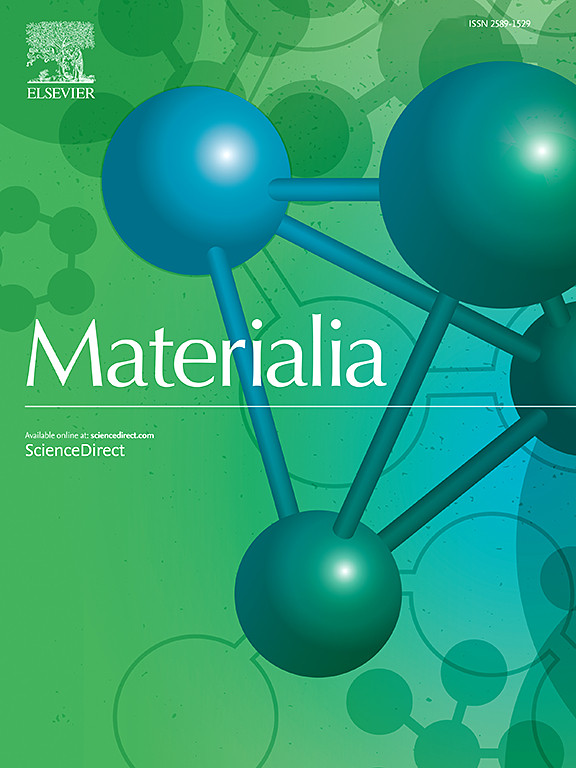控制α”马氏体的正交性:一种调整钛合金屈服比和断裂强度-塑性平衡的新策略
IF 3
Q2 MATERIALS SCIENCE, MULTIDISCIPLINARY
引用次数: 0
摘要
为了解决调整屈服比和打破钛合金强度-延性权衡的关键挑战,我们提出了一种新的设计策略,即在一种铝当量([Al]eq)约为6、钼当量([Mo]eq)在7-8范围内(即Ti-6[Al]eq-7 ~ 8[Mo]eq)的钛(Ti)合金中形成由初级α相(αp)和α”马氏体组成的双相组织。通过固溶处理和低温时效对α”马氏体的正交性进行精确控制,Ti6Al4V5.5Cu (wt.%)模型合金的屈服强度可由465 MPa逐步提高到1050 MPa。同时,保留了大伸长率(εp, ~ 17%)和高极限抗拉强度(UTS, ~ 1200 MPa),从而在大范围内实现了屈服强度和屈服比的理想组合,同时克服了屈服强度与延性的权衡。可调节的屈服强度和屈服比源于α”马氏体正交性的调节,而α”马氏体在拉伸变形过程中由正交向近六角形组织的连续转变是应变诱导的结果,具有良好的塑性和加工硬化能力。通过α“马氏体正交性工程获得的各种拉伸性能组合为设计多功能钛合金提供了新的见解,使其能够满足各种加工和应用场景的需求。本文章由计算机程序翻译,如有差异,请以英文原文为准。

Manipulating the orthorhombicity of α" martensite: A novel strategy to tailor yield ratio and break strength–ductility trade-off in titanium alloys
In addressing the critical challenge of tailoring yield ratio and breaking the strength–ductility trade-off in titanium alloys, we have proposed a novel design strategy by forming a dual-phase microstructure, which consists of primary α phase (αp) and α" martensite in a type of titanium (Ti) alloy with an aluminum equivalency ([Al]eq) of approximately 6 and a molybdenum equivalency ([Mo]eq) in the range of 7–8 (i.e., Ti-6[Al]eq-7∼8[Mo]eq). Through precise manipulation of the orthorhombicity of α" martensite via solution treatment and low-temperature ageing, the yield strength of the Ti6Al4V5.5Cu (wt.%) model alloy can be progressively enhanced from 465 MPa to 1050 MPa. Meanwhile, the great elongation (εp, ∼17 %) and high ultimate tensile strength (UTS, ∼1200 MPa) are preserved, thus achieving a desirable combination of yield strength and yield ratio over a wide range and overcoming the yield strength–ductility trade-off simultaneously. The adjustable yield strength and yield ratio arise from the modulation of the orthorhombicity of α" martensite, and the great ductility and work-hardening capacity are attributed to the strain-induced continuous transformation of α" martensite from an orthorhombic structure to a near-hexagonal structure during tensile deformation. The diverse combinations of tensile properties achieved through this α" martensite orthorhombicity engineering provide new insights for designing versatile Ti alloys, enabling them to meet the demands of various processing and application scenarios.
求助全文
通过发布文献求助,成功后即可免费获取论文全文。
去求助
来源期刊

Materialia
MATERIALS SCIENCE, MULTIDISCIPLINARY-
CiteScore
6.40
自引率
2.90%
发文量
345
审稿时长
36 days
期刊介绍:
Materialia is a multidisciplinary journal of materials science and engineering that publishes original peer-reviewed research articles. Articles in Materialia advance the understanding of the relationship between processing, structure, property, and function of materials.
Materialia publishes full-length research articles, review articles, and letters (short communications). In addition to receiving direct submissions, Materialia also accepts transfers from Acta Materialia, Inc. partner journals. Materialia offers authors the choice to publish on an open access model (with author fee), or on a subscription model (with no author fee).
 求助内容:
求助内容: 应助结果提醒方式:
应助结果提醒方式:


